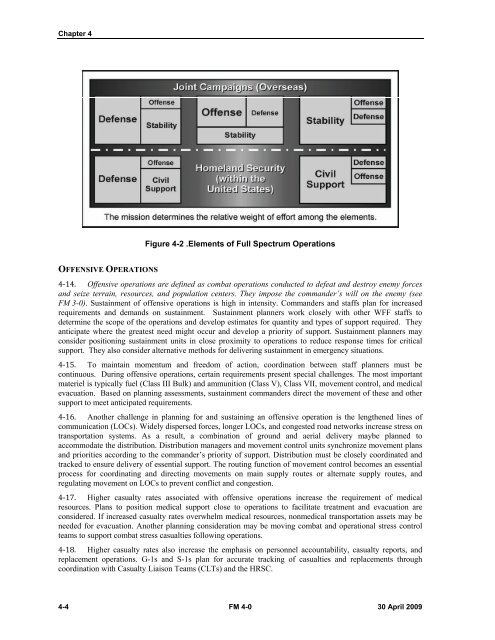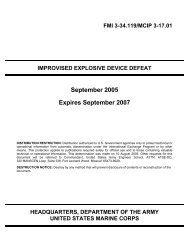Chapter 4Figure 4-2 .Elements of Full Spectrum OperationsOFFENSIVE OPERATIONS4-14. Offensive operations are defined as combat operations conducted to defeat and destroy enemy forcesand seize terrain, resources, and population centers. They impose the commander’s will on the enemy (see<strong>FM</strong> 3-0). <strong>Sustainment</strong> of offensive operations is high in intensity. Commanders and staffs plan for increasedrequirements and demands on sustainment. <strong>Sustainment</strong> planners work closely with other WFF staffs todetermine the scope of the operations and develop estimates for quantity and types of support required. Theyanticipate where the greatest need might occur and develop a priority of support. <strong>Sustainment</strong> planners mayconsider positioning sustainment units in close proximity to operations to reduce response times for criticalsupport. They also consider alternative methods for delivering sustainment in emergency situations.4-15. To maintain momentum and freedom of action, coordination between staff planners must becontinuous. During offensive operations, certain requirements present special challenges. The most importantmateriel is typically fuel (Class III Bulk) and ammunition (Class V), Class VII, movement control, and medicalevacuation. Based on planning assessments, sustainment commanders direct the movement of these and othersupport to meet anticipated requirements.4-16. Another challenge in planning for and sustaining an offensive operation is the lengthened lines ofcommunication (LOCs). Widely dispersed forces, longer LOCs, and congested road networks increase stress ontransportation systems. As a result, a combination of ground and aerial delivery maybe planned toaccommodate the distribution. Distribution managers and movement control units synchronize movement plansand priorities according to the commander’s priority of support. Distribution must be closely coordinated andtracked to ensure delivery of essential support. The routing function of movement control becomes an essentialprocess for coordinating and directing movements on main supply routes or alternate supply routes, andregulating movement on LOCs to prevent conflict and congestion.4-17. Higher casualty rates associated with offensive operations increase the requirement of medicalresources. Plans to position medical support close to operations to facilitate treatment and evacuation areconsidered. If increased casualty rates overwhelm medical resources, nonmedical transportation assets may beneeded for evacuation. Another planning consideration may be moving combat and operational stress controlteams to support combat stress casualties following operations.4-18. Higher casualty rates also increase the emphasis on personnel accountability, casualty reports, andreplacement operations. G-1s and S-1s plan for accurate tracking of casualties and replacements throughcoordination with Casualty Liaison Teams (CLTs) and the HRSC.4-4 <strong>FM</strong> 4-0 30 April 2009
Integrating <strong>Sustainment</strong> into Operations4-19. Plans should also provide for religious support, which may become critical during offensiveoperations. Religious support through counseling and appropriate worship can help reduce combat stress,increase unit cohesion, and enhance performance.4-20. Using contractors during the sustainment of offensive operations entails great risk and raisessignificant practical and legal considerations. However when necessary, the force commander may be willing toaccept this risk and use contractors in forward areas. Commanders should seek counsel from their judgeadvocates when considering the use of contractors during offensive operations.DEFENSIVE OPERATIONS4-21. Defensive operations defeat an enemy attack, gain time, economize forces, and develop conditionsfavorable for offensive or stability operations (<strong>FM</strong> 3-0). The commander positions assets so they can supportthe forces in the defense and survive. Requirements for sustainment of forces in the defense depend on the typeof defense. For example, increased quantities of ammunition and decreased quantities of fuel characterize mostdefensive operations. However, in a mobile defense, fuel usage may be a critical factor. Conversely, in a fixeddefensive position, fuel requirements are lower.4-22. Typically, defensive operations require more centralized control. Movements of supplies,replenishment, and troops within the AO have to be closely and continuously coordinated, controlled, andmonitored. In retrograde operations (a type of defense) special care is necessary to assure that combat unitsreceive necessary support across the depth of the AO and that the sustainment unit and stocks are not lost as theunit moves away from enemy activity.4-23. Distribution managers direct resupply forecasted items to designated units. Increases in items such asbarrier and construction materials should be pushed to designated collection points for unit retrieval wheneverpossible. Planners should consider the impact of increased ammunition expenditures on available transportationassets.4-24. The task of medical units is to triage casualties, treat, and return to duty or resuscitate and stabilize forevacuation to the next higher level of medical care or out of the theater of operations. MTFs and other AHSsupport assets should be placed within supporting distance of maneuver forces but not close enough to impedeongoing combat operations.STABILITY OPERATIONS4-25. Stability operations encompass various military missions, tasks, and activities conducted outside theUnited States in coordination with other instruments of national power to maintain or reestablish a safe andsecure environment, provide essential governmental services, emergency infrastructure reconstruction, andhumanitarian relief (<strong>FM</strong> 3-0). Although Army forces focus on achieving the military end state, they ultimatelyneed to create conditions where the other instruments of national power are preeminent. <strong>Sustainment</strong> of stabilityoperations often involves supporting U.S. and MNFs in a wide range of missions and tasks. The tasks mostimpacted by sustainment are briefly discussed below.Establish Civil Security4-26. Civil security involves providing for the safety of the host nation and its population, includingprotection from internal and external threats (<strong>FM</strong> 3-0). <strong>Sustainment</strong> staffs must consider plans to support I/Roperations. <strong>Sustainment</strong> may be provided to these operations until HNS, NGO, and OGOs are available.4-27. <strong>Sustainment</strong> planners must address the sustainment of I/R operations. <strong>Sustainment</strong> to I/R involves allof the sustainment functions. Planners should consider general engineering support horizontal and verticalconstruction of detention centers, as well as repair and maintenance of the infrastructure (see <strong>FM</strong> 3-34.400). Amore detailed discussion of sustainment support of I/R and detainee operations will be provided later in thischapter.30 April 2009 <strong>FM</strong> 4-0 4-5

















